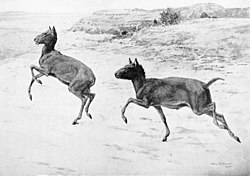Top Qs
Timeline
Chat
Perspective
Santa Cruz Formation
Geological formation in Patagonia From Wikipedia, the free encyclopedia
Remove ads
The Santa Cruz Formation is a geological formation in the Magallanes/Austral Basin in southern Patagonia in Argentina and adjacent areas of Chile. It dates to the late Early Miocene epoch, and is contemporaneous with the eponymous Santacrucian age of the SALMA (South American land mammal age) timescale.[1][2] The Santa Cruz Formation is known for its abundance of vertebrate fossils, including South American native ungulates (astrapotheres, litopterns, notoungulates),[3] as well as rodents, xenarthrans (armadillos, sloths, anteaters), and metatherians.
The formation extends from the Andes to the Atlantic coast. In its coastal section it is divided into two members, the lower, fossil rich Estancia La Costa Member, which consists predominately of tuffaceous deposits and fine grained mudrock, and the upper fossil-poor Estancia La Angelina Member, which consists of sedimentary rock, primarily mudrock, and sandstone. The environment of deposition was mostly fluvial, with the lowermost part of the Estancia La Costa Member being transitional between fluvial and marine conditions. The environment of the Estancia La Costa Member is thought to have been relatively warm and humid, but likely became somewhat cooler and drier towards the end of the sequence.[1]
Remove ads
Stratigraphy
Summarize
Perspective
The Santa Cruz Formation is exposed in isolated outcrops across the Magallanes/Austral Basin extending from the Atlantic coast to the Andes, especially along the Santa Cruz River, as well as along the southern coastline of Santa Cruz Province.[4] While primarily located in Argentina, small outcrops are also found in Chile.[5] The base of the formation is defined by a marine regression event transitioning from the marine environment of the underlying Monte Léon Formation, which formed when large areas of Patagonia were submerged as a part of the Patagoniense Transgression.
The main source of sediment input to the basin was from the Andean orogeny to the west. The formation reaches a maximum thickness of over 295 meters, though the total thickness of the formation is strongly controlled by subsequent erosion and the 295 meters likely does not represent a complete sequence. The formation primarily consists of floodplain deposits. The lower parts of the formation have an abundance of tuffs and tuffaceous sediments. These likely originated from distant eruptions that were transported into the basin by aerial fallout, wind and/or river transport. The formation likely spans an approximately 3 million year interval in the late Early Miocene around 18 to 15.2 million years ago, during the Burdigalian and Langhian stages.[4]
Remove ads
Paleoenvironment
The environment of the Santa Cruz Formation is thought to have been relatively warm and humid, including a mix of open savanna, gallery forests and semi-deciduous forests. Permanent bodies of water such as lakes, ponds and streams are likely to have been present.[6]
Paleoflora
Paleofauna
Summarize
Perspective
Invertebrates
Amphibians
Birds
Squamates
Mammals
Meridiungulates
Astrapotheres
Litopterns
Notoungulates
Xenarthrans
Pilosa
Cingulata
Metatherians
Rodents
Primates
Meridiolestida
Remove ads
References
Wikiwand - on
Seamless Wikipedia browsing. On steroids.
Remove ads











































